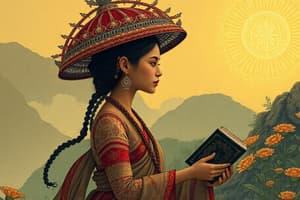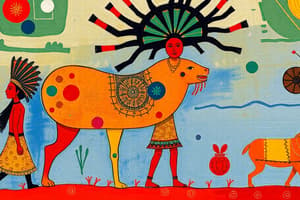Podcast
Questions and Answers
Who is one of the main characters in Hinilawod?
Who is one of the main characters in Hinilawod?
Labaw Donggon
Name one monster encountered according to the journey in Hinilawod.
Name one monster encountered according to the journey in Hinilawod.
Dumalapdap
Which of the following is a place mentioned in Hinilawod? (Select all that apply)
Which of the following is a place mentioned in Hinilawod? (Select all that apply)
- Dumalapdap (correct)
- Maria Cacao
- Labaw Donggon (correct)
- Humadapnon (correct)
What is Maria Cacao associated with in Hinilawod?
What is Maria Cacao associated with in Hinilawod?
What is the significance of 'The Origin of the Black Sto. Nino' in Hinilawod?
What is the significance of 'The Origin of the Black Sto. Nino' in Hinilawod?
Flashcards are hidden until you start studying
Study Notes
Characters
- Labaw Donggon is a supernatural hero who is the central character of the epic Hinilawod
- Humadapnon is Labaw Donggon's brother who is the main antagonist of the epic.
- Dumalapdap is a character featured in Humadapnon's section of the epic who is a monster or “aswang” (creature) with the ability and tendency to take human form.
Places
- Labaw Donggon battles numerous monsters that are associated with certain places.
- The first battle of Labaw Donggon takes place around his village, “the place where he dwells,” at the edge of a mountain, “the place where all kinds of giants live,” with a monster that appears from the clouds “which resembles the shape of a large piece of cloth that is floating in the sky,” called the Maglalangis.
- Labaw Donggon then battles a monster called the Dinumog which appears from the ocean, “where the sea turtles live,” which is described as a giant fish with a “huge mouth and teeth like swords.”
- Labaw Donggon then battles two monsters known as the “monsters that can fly at a great speed,” called the Pagbabalati in the direction of the clouds.
- The epic then describes the “large forest” where the monster, called a “Pagbabalati,” lived after the battle.
- The epic continues to detail another battle with the “monsters that can fly at a great speed, in the sky where the stars are,” called the Talintong.
- Humadapnon also fights monsters as he attempts to find Labaw Donggon to kill and take the position of highest authority in “the place where the forest of the trees of the sky grew,” called the “Kaduangan.”
- The epic outlines the “enchanted place” that Labaw Dongoon has called “The Enchanted Mountain” where the “Maglalangis” lives and “a great river in the sky” in the “Kaduangan” where Humadapnon battles Dumalapdap for control of the “Kaduangan” known as “the place where Labaw Donggon dwells.”
Monsters and Battles
- Labaw Donggon's first battle takes place with the “monsters that can fly at a great speed” which is a "monster that appears from the clouds,” called the Maglalangis.
- The Maglalangis is described as "a large piece of cloth that is floating in the sky,” that Labaw Donggon battles with his sword and “hits with great force,” killing the Malalalangis.
- The second creature battled by Labaw Donggon is a monster called the Dinumog which “resembles a large fish,” that appears “out of the sea where the sea turtles live,” which is described as a giant fish with a “huge mouth and teeth like swords,” “a body like a boat, and fins like those of a carabao.”
- The Dinumog "resembles a large fish, it has two horns, its body is made of iron, and its feet are made of steel.” The battle ensues, “its great sword and shield are used, the sword of the hero strikes the tail of the monster.” The creature is ultimately killed and chopped up into pieces.
- Labaw Donggon battles two creatures known as the monsters that can fly at a great speed “which have sharp claws,” the Pagbabalati, one that descends “from the sky where the stars are,” which is described as "like a monster that is flying at great speed,” while the other "soared from the clouds like a shooting star,” and “like a hawk that is about to catch its prey, and made a loud noise, and struck like a thunder,” all of which are killed by Labaw Donggon.
- Labaw Donggon then battles a monster of the “Pagbabalati” variety, “called a monster of the air, which is a very strong monster,” “which has a body of clouds, and has sharp claws like swords,” in the “Kaduangan.” Labaw Donggon "assaulted the monster and sliced off its wings” and the “monster fell dead, and its blood flowed into the river” of the “Kaduangan.”
- His fifth battle, with the “monsters that can fly at a great speed,” called the Talintong, that are described as “which have sharp claws and wings that look like those of a hawk, and with sharp beaks, and a body that is made of iron.” Labaw Donggon defeats them in a “loud battle with the sword.”
- Humadapnon fights monsters as he attempts to find Labaw Donggon to kill and take the position of highest authority in “the place where the forest of the trees of the sky grew.” It is in this place, the “Kaduangan,” where Humadapnon battles Dumalapdap for control of the “Kaduangan,” known as “the place where Labaw Donggon dwells.”
- Dumalapdap does not have a clear description; however, it is revealed that Dumalapdap can shapeshift.
Things and Terms
- The Hinilawod is a traditional epic from the Philippines that is written in the Bisaya and Bukidnon languages.
- The epic is named after the “Hinilawod vine” or “Bejuco” which is a type of vine that serves as a key element to the story as both of the main characters, Labaw Donggon and his brother Humadapnon, use the vine to travel great distances.
- The epic tells the story of Labaw Donggon, who is a hero of the Visayan people, and his brother Humadapnon.
- The epic is based on the indigenous traditions of the Visayan people, and it tells the stories of gods, heroes, and monsters, and also “deals with the themes of love, war, and the power of nature.”
- The epic has been passed down orally for many generations, and it has been written down in recent years.
- The text contains numerous words that are of interest.
- The text includes the word “aswang” or “aswang”which refers to a type of Filipino monster that is usually depicted as a flying creature with sharp claws and teeth.
Maria Cacao
- Maria Cacao is a story in the “Mga Sugilanon” that showcases a "young lady" with the name "Maria Cacao" who is known locally as “the most beautiful woman in the barrio.”
- The story features romantic themes with a “wealthy and handsome young man” who takes “the love” of Maria Cacao "without paying" the “traditional gift” of “a dowry.”
- Maria Cacao is “ashamed to be seen naked, so she was never seen walking outside her home without a shirt.”
- The story revolves around Maria Cacao’s love for her “very dear friend” who "is like a brother to her," and how she is afraid “that their friendship will be ruined” when the “wealthy young man” decides that “his love for her is so intense" that he "continues to follow her everywhere she goes.”
The Tuba Gatherer
- The Tuba Gatherer is a story in the “Mga Sugilanon” which narrates the “fable” of a “young man” who decides to “go to the forest to gather tuba.”
- The Tuba Gatherer story features a “creature that resembled a large human being, with a long, black beard” that “approached the young man's house,” “a huge, white-haired monkey,” and their “interaction with the young man."
- The story highlights a theme associated with an “old monkey,” and the “creature's appearance,” which inspires the young man to follow and live with the monkey to “learn the secrets of the forest.”
The Origin of the Black Sto. Nino
- The Origin of the Black Sto. Nino is a story where “the people of the town” and “the priest of the town” are trying to figure out “why” the “black Sto. Nino is black.”
- The story showcases the “beliefs and traditions” that are “related to religion.”
- The story explains “how” the “people of the town” “interpreted” the Black Sto. Nino’s "black color,” which “eventually” “becomes a symbol of the unity and faith of the people,” who “believe” that the “black color symbolizes the people’s “suffering and struggles.”
Studying That Suits You
Use AI to generate personalized quizzes and flashcards to suit your learning preferences.


